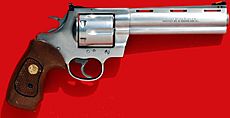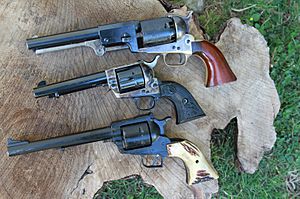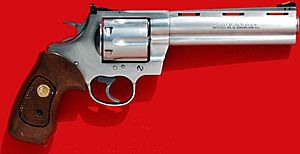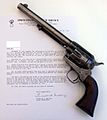Revolver facts for kids
A revolver is a type of gun that can fire several shots without needing to be reloaded after each shot. Revolvers have a special part called a cylinder that spins. This cylinder has several small spaces, called chambers, and each chamber holds one bullet (or cartridge). Most revolvers are small enough to be held with one hand, making them a type of handgun.
People have used revolvers since the late 1500s in Europe. However, they became much more common and affordable in the 1700s and 1800s. Sometimes, police officers use revolvers. These guns are also known as revolving guns, but the name revolver is used much more often.
Contents
How Revolvers Work
Revolvers work in different ways, depending on how their firing system is set up. The two main types are "single-action" and "double-action."
Single-Action Revolvers
In a single-action revolver, you have to do one step yourself before firing. You must manually pull back the hammer (the part that strikes the bullet) with your thumb. When you pull the hammer back, two things happen:
- The cylinder spins to bring a new bullet into position.
- The cylinder locks in place, ready to fire.
Once the hammer is pulled back, the gun is "cocked." Then, when you pull the trigger, it simply releases the hammer, which fires the bullet. To fire another shot, you must pull the hammer back again. This is called "single-action" because the trigger only does one thing: it releases the hammer.
Because the trigger only releases the hammer, it usually feels lighter and easier to pull. This can help shooters be more accurate. Also, having to cock the hammer manually acts like a safety feature. The gun won't fire unless the hammer is pulled back first. Famous examples of single-action revolvers include the Colt Paterson and the Colt Single Action Army, which were popular during the American Frontier era.
Double-Action Revolvers
Double-action revolvers are different because pulling the trigger does more than one thing. When you pull the trigger on a double-action revolver, it does three actions all at once:
- It pulls the hammer back into the cocked position.
- At the same time, it spins the cylinder to load the next bullet.
- It then releases the hammer to fire the bullet.
Because the trigger does all these actions, you don't need to manually cock the hammer before each shot. Every time you pull the trigger, a bullet is fired. This means you can carry the gun without it being cocked and fire it quickly just by pulling the trigger.
However, the trigger pull on a double-action revolver is usually longer and harder. While this can make it a bit harder to shoot accurately for some, it also acts as a safety feature. The heavier trigger pull makes it less likely for the gun to fire by accident, for example, if it's dropped.
Most double-action revolvers can actually be used in two ways:
- Single-action mode: You can still pull the hammer back with your thumb, just like a single-action revolver. This makes the trigger pull lighter when you fire.
- Double-action mode: You can fire from a "hammer-down" position. In this case, pulling the trigger first cocks the hammer and rotates the cylinder, then fires the bullet. This is when the trigger pull is much heavier.
Images for kids
See also
 In Spanish: Revólver para niños
In Spanish: Revólver para niños




















